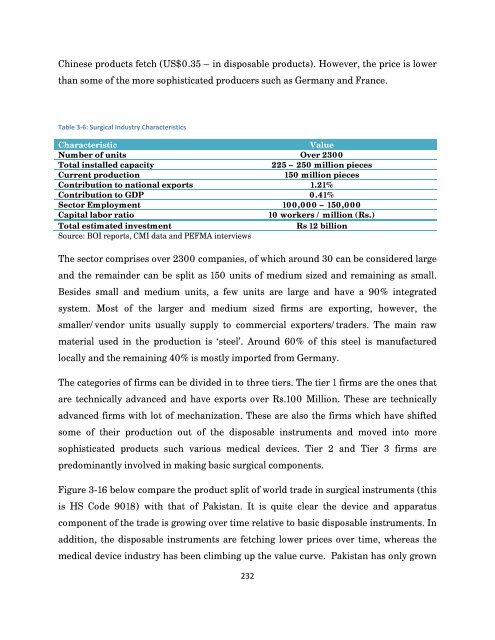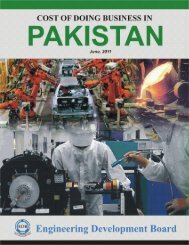- Page 1 and 2:
INDUSTRIAL POLICY, ITS SPATIAL ASPE
- Page 3 and 4:
Table of Contents List of Tables ..
- Page 5 and 6:
3.3.13 Fisheries Sector ...........
- Page 7 and 8:
List of Tables Chapter 2 Table 2‐
- Page 9 and 10:
List of Figures Chapter 2 Figure 2
- Page 11 and 12:
Figure 4‐12: Spatial inequality i
- Page 13 and 14:
Acronyms and Abbreviations ADR Alte
- Page 15 and 16:
Acknowledgements This study has bee
- Page 17 and 18:
percent average GDP growth rate, th
- Page 19 and 20:
Development Fund and a Skill based
- Page 21 and 22:
knowledge based industries such as
- Page 23 and 24:
Therefore, we recommend specific ty
- Page 25 and 26:
manufacturing industries is widespr
- Page 27 and 28:
• Expansion of the tax base by in
- Page 29 and 30:
• In special economic zones, scie
- Page 31 and 32:
which could cross from Iranian to P
- Page 33 and 34:
• Provide infrastructure of the p
- Page 35 and 36:
transaction cost of smuggling and r
- Page 37 and 38:
Accordingly, the government should
- Page 39 and 40:
information flows between the train
- Page 41 and 42:
etc., that operate outside the form
- Page 43 and 44:
In view of the credit problems face
- Page 45 and 46:
• Establishment of testing and ce
- Page 47 and 48:
the interim period the Ministry sho
- Page 49 and 50:
growth of downstream industries esp
- Page 51 and 52:
• Strictly enforce the Tariff-bas
- Page 53 and 54:
• New courses in systems design m
- Page 55 and 56:
• Allow long-term subcontracting
- Page 57 and 58:
in KP. The total production of the
- Page 59 and 60:
• Keep on supporting PHDEC to imp
- Page 61 and 62:
Sports Goods Sports Goods industry
- Page 63 and 64:
• Ensure that the ceramics centre
- Page 65 and 66:
• Allow free import at 0-5% for 3
- Page 67 and 68:
• Operationlaise the planned marb
- Page 69 and 70:
• Support provision of market inf
- Page 71 and 72:
In order to improve the competitive
- Page 73 and 74:
• Advocate the use of pre-fabrica
- Page 75 and 76:
diversification which has been a ma
- Page 77 and 78:
gives a brief synopsis of the compe
- Page 79 and 80:
The 1980s brought a major shift in
- Page 81 and 82:
the costs of entry for a pioneer fi
- Page 83 and 84:
macro level investigation of indust
- Page 85 and 86:
on its own. The Government of Pakis
- Page 87 and 88:
Source: IMF, 2008 However, in the p
- Page 89 and 90:
2.1.2 Structural Rigidity & Inadequ
- Page 91 and 92:
share in formal non-agriculture emp
- Page 93 and 94:
Breaking down the analysis of manuf
- Page 95 and 96:
Moreover, during the 1990s, total f
- Page 97 and 98:
Figure 2‐13: Output per Worker Gr
- Page 99 and 100:
of world exports increased on avera
- Page 101 and 102:
More so, the product concentration
- Page 103 and 104:
The underlying reason for South Asi
- Page 105 and 106:
Source: Felipe and Lim, 2008 2.1.5
- Page 107 and 108:
order to bring about technological
- Page 109 and 110:
sector. The role of the government
- Page 111 and 112:
eforms in particular trade liberali
- Page 113 and 114:
07. In the last two years, the priv
- Page 115 and 116:
from 12% to 24% of total investment
- Page 117 and 118:
2005-07 controlling for the size of
- Page 119 and 120:
skewed away from the manufacturing
- Page 121 and 122:
sustained growth and wide spread em
- Page 123 and 124:
interest rate remained stable in th
- Page 125 and 126:
45.00 40.00 35.00 30.00 25.00 20.00
- Page 127 and 128:
Source: Felipe and Lim (2008). Rece
- Page 129 and 130:
increased as a premium for being a
- Page 131 and 132:
The government faces an immediate n
- Page 133 and 134:
services, TRIPs (Trade Related Inte
- Page 135 and 136:
most of the burden, for e.g., those
- Page 137 and 138:
that it comes second only to Bangla
- Page 139 and 140:
Box 2‐2: Energy in Comparison wit
- Page 141 and 142:
Hydel or Hydropower While the gener
- Page 143 and 144:
announced at least two months in ad
- Page 145 and 146:
network. Road linkages connecting m
- Page 147 and 148:
Ministry of Industries and Producti
- Page 149 and 150:
According to the World Bank (2004),
- Page 151 and 152:
Absence or weakness of skills in th
- Page 153 and 154:
and Nazli (1998)]. In Balochistan,
- Page 155 and 156:
Source: PIHS (2001-02 and 2005-2006
- Page 157 and 158:
Pakistan do not consider inadequate
- Page 159 and 160:
curricula, poor quality of instruct
- Page 161 and 162:
also to enhance information flows b
- Page 163 and 164:
shortage of qualified textile profe
- Page 165 and 166:
Figure 2‐36: growth in lending by
- Page 167 and 168:
the average value of the collateral
- Page 169 and 170:
The procedural requirements such as
- Page 171 and 172:
2.3.3.6 Policy Recommendations: The
- Page 173 and 174:
approving the certification bodies,
- Page 175 and 176:
Balochistan Sindh Punjab NWFP Small
- Page 177 and 178:
of manufacturing the tyre. Such ina
- Page 179 and 180:
Cost (% of Claim) Source: World Ban
- Page 181 and 182:
Due to the tax rates and complicate
- Page 183 and 184:
are: import duties, import surcharg
- Page 185 and 186:
Competitiveness & Industry Stagnati
- Page 187 and 188:
egional competitors like India and
- Page 189 and 190:
the overall TFP growth rate to 0.9
- Page 191 and 192:
aiding hidden sugar stocks. This il
- Page 193 and 194:
Second, a science park captures the
- Page 195 and 196:
This should be done while preservin
- Page 197 and 198:
• Pilot projects that help demons
- Page 199 and 200:
ecome too costly for more developed
- Page 201 and 202:
inputs/raw material by the domestic
- Page 203 and 204:
Table 3‐1: Demand for Petrochemic
- Page 205 and 206: products is reasonable (import of e
- Page 207 and 208: 3.1.2 Steel Industry Steel is a cri
- Page 209 and 210: scrap and serviceable engineering g
- Page 211 and 212: sector. Investments in improved fer
- Page 213 and 214: Figure 3‐5: Comparison of Pakista
- Page 215 and 216: 3.2 Value Added Knowledge Based Ind
- Page 217 and 218: About 75% of the firms supply to th
- Page 219 and 220: Electronics is one of the largest m
- Page 221 and 222: 3.2.2.1.2 Lack of Technological Kno
- Page 223 and 224: 3.2.2.1.4 Trade through Illegal Cha
- Page 225 and 226: 3.2.2.2 Policy Recommendations: The
- Page 227 and 228: new patent laws under the TRIPs whi
- Page 229 and 230: Figure 3‐8: Broad Comparison of P
- Page 231 and 232: • Income Tax: The advanced income
- Page 233 and 234: 3.3 Value Added Skill & Engineering
- Page 235 and 236: • Adequate human resource with gr
- Page 237 and 238: etween 5-10 years. Sales are also f
- Page 239 and 240: 3.3.2.1.1 Low levels of productivit
- Page 241 and 242: etc are fetching much higher export
- Page 243 and 244: • Strongly advocate with State Ba
- Page 245 and 246: The above composition suggests that
- Page 247 and 248: Out of this 70% of the cost is for
- Page 249 and 250: • Similarly, grinding is done usi
- Page 251 and 252: The industry seems to be doing reas
- Page 253 and 254: Another major area that has restric
- Page 255: for such industry already exists in
- Page 259 and 260: more than the producer. The mean re
- Page 261 and 262: 3.3.5.2 Policy Recommendations: The
- Page 263 and 264: US$0.26 billion in 2009 from a high
- Page 265 and 266: Figure 3‐21: Typical Value of Han
- Page 267 and 268: 3.3.6.3 Policy Recommendations: Sin
- Page 269 and 270: Source: UN Commodity Trade Statisti
- Page 271 and 272: • Ensure that the Ceramics Indust
- Page 273 and 274: level of quality control, inefficie
- Page 275 and 276: Figure 3‐25: Key Challenges in Pa
- Page 277 and 278: Another issue faced by the furnitur
- Page 279 and 280: 3.3.8.4 Policy Recommendations: It
- Page 281 and 282: 675 tanneries in the formal sector,
- Page 283 and 284: • Limited availability of modern
- Page 285 and 286: 3.3.10 Gems & Jewellery Sector Paki
- Page 287 and 288: Raw Mat erial Waste is 7% Filing &
- Page 289 and 290: 3.3.10.2 Policy Recommendations: Ca
- Page 291 and 292: 3.3.11.1 Value Chain Analysis Value
- Page 293 and 294: capable of processing stone in acco
- Page 295 and 296: Figure 3‐29: Traditional Quarryin
- Page 297 and 298: of the NEEDS. Below we have summari
- Page 299 and 300: 3.3.12.1.9 Levy of Federal Excise D
- Page 301 and 302: production assets and technology. T
- Page 303 and 304: Source: ‘Pakistan: Growth and exp
- Page 305 and 306: • Explore possibility of increasi
- Page 307 and 308:
3.3.12.12 Electrical Fittings The e
- Page 309 and 310:
scale commercial fishing vessels. I
- Page 311 and 312:
overtime, we freeze the district bo
- Page 313 and 314:
The phenomenon of localized versus
- Page 315 and 316:
4.3 Mapping Measures of Regional an
- Page 317 and 318:
Source: GoP (2001) Khan (2003) disc
- Page 319 and 320:
Log of population 2005-06 13 14 15
- Page 321 and 322:
Log of population growth from 1981-
- Page 323 and 324:
Ghaus-Pasha and Jamal; 1996-97 Jafr
- Page 325 and 326:
FBS 2550 calories -- -- 26.6 29.3 2
- Page 327 and 328:
eginning; it has remained constant
- Page 329 and 330:
Figure 4‐5: Poverty headcount in
- Page 331 and 332:
a ratio equal to twice the area bet
- Page 333 and 334:
egistered slightly increasing magni
- Page 335 and 336:
4.3.3 Evidence on Spatial Dispariti
- Page 337 and 338:
system in each district. Since thes
- Page 339 and 340:
Intermediate college size -0.047 0.
- Page 341 and 342:
Table 4‐10: Most and least develo
- Page 343 and 344:
eporting of data. However, district
- Page 345 and 346:
Figure 4‐10: Industry clusters an
- Page 347 and 348:
4.3.4 Market Access and Spatial Ine
- Page 349 and 350:
Figure 4‐12: Spatial inequality i
- Page 351 and 352:
indicates that Peshawar, Abbottabad
- Page 353 and 354:
Moreover, we also present evidence
- Page 355 and 356:
Table 4‐11: Change in concentrati
- Page 357 and 358:
Next, we discuss the geographic con
- Page 359 and 360:
313 Beverage industry 32 36 16 -0.0
- Page 361 and 362:
Table 4‐13: Geographic concentrat
- Page 363 and 364:
district, it is termed as urbanizat
- Page 365 and 366:
Table 4‐15: Localisation versus u
- Page 367 and 368:
5 Poverty Impacts of Public Investm
- Page 369 and 370:
landholding and the incidence of po
- Page 371 and 372:
ijt household and individual level
- Page 373 and 374:
individual characteristics. Column
- Page 375 and 376:
Financial assets owned by household
- Page 377 and 378:
Mardan =1 if individual belongs to
- Page 379 and 380:
Survey year 1992-93× Punjab 0.073
- Page 381 and 382:
Table 5‐4: Effects of household a
- Page 383 and 384:
is roughly similar, except that mal
- Page 385 and 386:
Pseudo R 2 0.131 0.131 Notes: All r
- Page 387 and 388:
Survey year 1996-97 0.139 0.346 0 1
- Page 389 and 390:
status dummies and province-year fi
- Page 391 and 392:
unchanged until 1996-97. This is re
- Page 393 and 394:
the whole country, f ( yi ) is the
- Page 395 and 396:
Province× year fixed effects inclu
- Page 397 and 398:
Individual level controls included
- Page 399 and 400:
We take corresponding data from Pak
- Page 401 and 402:
second five year period, industry a
- Page 403 and 404:
oads density variable is positive a
- Page 405 and 406:
complete set of sub-industry (3-dig
- Page 407 and 408:
The two time dummies reflect produc
- Page 409 and 410:
0.125) in road density of a distric
- Page 411 and 412:
Fourthly, the literature tells us t
- Page 413 and 414:
References Ahmad, H., M. Mahmud, N.
- Page 415 and 416:
Competitiveness Support Fund (2010)
- Page 417 and 418:
Gelman, A., J.B. Carlin, H.S. Stern
- Page 419 and 420:
Henderson, J. V., Todd Lee, Yung J.
- Page 421 and 422:
Levine, Ross and Renelt, David (199
- Page 423 and 424:
Shabbir, T., A.H. Khan (1991). Minc
- Page 425:
World Development Report (2000). En





